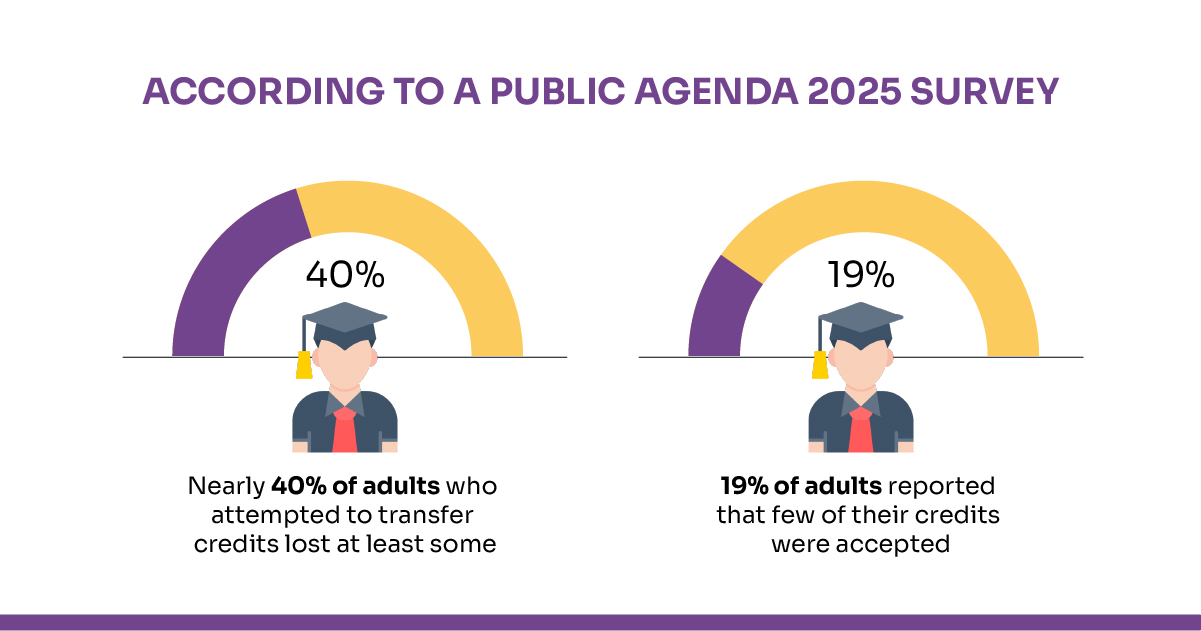Table Of Contents
In 2025, the landscape of credit transfer in U.S. higher education is evolving rapidly—powered by policy reform, institutional innovation, and growing student demand. According to a 2025 survey, nearly 40% of adults who attempted to transfer credits lost at least some, and 19% reported that few of their credits were accepted.

Nationally, transfer students lose an average of 13 credits, and almost 40% lose all credits, equating to nearly a year of coursework.
Despite these losses, some institutions are leading the way. Public universities dominate in transfer-friendliness. Arizona State University boasts a 90.7% acceptance rate for transfer applicants, while the University of Houston (88%), Michigan State (78%), and the University of Central Florida (67%) also rank high. Primary publics like UCLA, UC Berkeley, and Georgia Tech accept approximately 24–26% of transfer applicants—roughly three times their freshman acceptance rates.
Private and Ivy League institutions remain highly selective: for instance, Harvard accepted just 0.9% of transfer applicants, while Yale admitted 1.6% in recent cycles. On a promising note, Indian higher education has embraced central reform. In January 2025, the UGC Credit Transfer Rule and the Academic Bank of Credits system now allow students to seamlessly transfer credits between universities across India, with over 2.5 million registrations already recorded and institutions like Delhi University, BHU, and IGNOU processing thousands of transfers each.
As higher education shifts to a more modular and student‑centric model, selecting institutions with robust credit‑transfer policies is increasingly vital—for preserving time, minimising costs, and ensuring academic continuity.
What Is a Transfer Credit?
A transfer credit refers to academic credit that a student has earned at one educational institution and is accepted by another institution toward the completion of a degree or program. These credits typically come from previously completed college-level courses and are evaluated for equivalency by the receiving institution.
For example, suppose a student completes Calculus I at a community college and later transfers to a university. In that case, that university may count the course toward its degree requirements, allowing the student to skip repeating the same subject. However, acceptance of transfer credits depends on factors like course content, grade earned, accreditation of the original institution, and alignment with the new school’s curriculum.
There are different types of transfer credits:
- General education credits (like English, math, or science)
- Major-specific credits (directly related to your chosen field of study)
- Elective credits (courses that may not be core requirements but count toward total credit hours)
In the U.S., tools like Transferology, TES (Transfer Evaluation System), and institutional transfer guides help students understand what courses are likely to transfer. A well-managed transfer credit process can save students time, money, and academic frustration—making it a critical aspect of higher education planning.
Top 10 Colleges That Accept Transfer Credit

Transferring colleges is a strategic move that many students make—whether for better academic opportunities, lower tuition, proximity to home, or more flexible programs. In the U.S., nearly one-third of all college students transfer at least once before earning a degree. However, one of the biggest challenges in this process is credit transferability.
According to the U.S. Government Accountability Office, students lose an average of 43% of their credits when they transfer—leading to longer graduation timelines and increased costs. Fortunately, several institutions stand out for their strong articulation agreements, transparent policies, and student-centred tools that simplify the transfer process and maximise credit retention.
Below is a curated list of the Top 10 U.S. colleges and universities that excel at accepting transfer credits, based on transfer acceptance rates, policies, partnerships, and student support services.
Arizona State University (ASU)
ASU is a national leader in credit transfer and student mobility. It partners with community colleges across the U.S. through the Maricopa-ASU Pathways Program (MAPP) and MyPath2ASU, which outline course equivalencies and degree plans from day one. Students can transfer up to 64 lower-division credits and often retain almost all of their completed coursework. ASU also offers a Transfer Credit Guide and live chat tools to help students assess credit eligibility.
Transfer Acceptance Rate: 90.7%
University of Central Florida (UCF)
UCF is one of Florida’s largest and most transfer-friendly universities. It maintains 2+2 articulation agreements with many community colleges, especially through the DirectConnect to UCF program. Students are guaranteed admission if they earn an AA degree at one of the partner colleges. UCF accepts up to 60 transfer credits and offers dedicated transfer advisors and orientation.
Transfer Acceptance Rate: 67%
University of Houston (UH)
UH welcomes over 5,000 transfer students annually and accepts credits from both in-state and out-of-state institutions. It has strong partnerships with the Houston Community College System, offers Transfer Credit Estimators, and provides transfer scholarships up to $3,000 for qualifying students. Their Cougar Pathways Program simplifies transition and curriculum planning.
Transfer Acceptance Rate: 88%
Southern New Hampshire University (SNHU)
SNHU is a private university known for its online degree flexibility and generous transfer policy. It accepts up to 90 undergraduate credits, including CLEP and military credits, helping students fast-track their degrees. SNHU evaluates credits within 24–48 hours and provides a personal academic advisor throughout the process.
Transfer Acceptance Rate: High (flexible admissions
University of California, Los Angeles (UCLA)
As part of the UC system, UCLA is a top choice for California Community College students. It uses ASSIST.org to evaluate credit transfers and gives priority to applicants from the Transfer Alliance Program (TAP). UCLA generally allows the transfer of 70 semester/105 quarter units, focusing on general education and major preparation.
Transfer Acceptance Rate: 24–26% (higher than first-year acceptance rate)
University of North Carolina at Chapel Hill (UNC-Chapel Hill)
UNC is among the top public universities that actively support transfer students. It accepts up to 64 credits from two-year colleges and provides a Transfer Credit Evaluator Tool. UNC collaborates with the North Carolina Community College System, offering guaranteed pathways into specific majors.
Transfer Acceptance Rate: 35%
Oregon State University (OSU)
OSU’s Degree Partnership Program (DPP) allows students to be simultaneously enrolled at OSU and a community college, ensuring a seamless transfer of credits. The university accepts both in-state and out-of-state transfers and offers personalised credit evaluation and articulation support.
Transfer Acceptance Rate: 75%
University of Illinois Urbana-Champaign (UIUC)
UIUC uses the Illinois Articulation Initiative (IAI) to recognise core courses from Illinois community colleges. The Transfer Handbook outlines required and recommended courses by major. Students can transfer up to 60 credits, with specific programs (like Engineering) having strict prerequisites.
Transfer Acceptance Rate: 55%
Florida International University (FIU)
FIU supports thousands of transfer students annually through Florida’s 2+2 articulation agreement. It offers Panther Degree Pathways to map out transferable courses and guarantees admission to AA graduates from Florida public colleges. Transfer students also have access to scholarships and internships.
Transfer Acceptance Rate: 77%
Texas A&M University
Texas A&M has a comprehensive Automated Transfer Equivalency System (ATES) and works closely with Texas community colleges through the Blinn TEAM program. It accepts up to 60 transferable hours, and transfer students receive dedicated orientation and academic advising services.
Transfer Acceptance Rate: 57%
Common Challenges in the College Credit Transfer
Transferring college credits can be a challenging experience for students, often involving lengthy wait times and complicated paperwork. Consequently, many organisations and professionals in higher education are shifting towards comprehensive digital solutions to better assist learners in this process.
Keep reading to discover more about the challenges students encounter when transferring college credits.
Inconsistent Credit Evaluation Between Institutions
Every college has its own internal rules for determining which credits it accepts. Even if the same subject was covered at the previous institution, differences in course content, credit hours, faculty qualifications, or grading scales can result in denial.
Example: A “General Biology” course at a community college may not align with a university’s “Intro to Biological Sciences,” even though the topics appear similar on paper.
Accreditation Mismatches
Many institutions only accept credits from regionally accredited colleges. If a student transfers from a nationally accredited or unaccredited institution, their credits may not be recognised—regardless of academic performance.
Impact: A high-performing student from an unaccredited online college may be forced to retake all prior coursework when enrolling at a regionally accredited university.
Lack of Transparency and Credit Transfer Tools
One of the biggest frustrations is the uncertainty about what will transfer. Most colleges don’t provide a pre-admissions guarantee of credit equivalency. Students are often forced to apply, submit transcripts, and wait weeks or months for an evaluation.
Solution Gap: While some states offer platforms like ASSIST.org (California) or Transferology, many regions still lack unified tools.
Course Content Misalignment
Even if courses have similar names, their learning outcomes or instructional hours may not match. Institutions may decline credits if they believe the original course didn’t meet their standards.
Example: A 3-credit “Calculus I” at one college may not be accepted by a university that requires 4-credit Calculus courses with additional lab work.
Credit Hour Disparities (Semester vs Quarter Systems)
Colleges operating on different academic calendars (semester vs quarter) often have difficulty translating credits. A course completed under the quarter system may equate to fewer semester hours, creating gaps in program requirements.
Impact: Students might need to take extra classes to meet full credit loads, even if they’ve already studied the topic.
Lost or Incomplete Transcripts & Documentation
Missing course descriptions, outdated syllabi, or improperly submitted transcripts can delay or block the evaluation process. If detailed documentation isn’t provided, institutions may deny credit altogether.
Student Burden: Students are often responsible for chasing down course details from years ago to validate content.
Limited or Inadequate Academic Advising
Transfer students frequently receive less advising support than first-time freshmen. Without proper guidance, students may enrol in non-transferable courses or miss application deadlines, which can worsen credit loss.
Consequence: Poor advising can result in repeated courses, wasted tuition, and delayed graduation.
Rejection of Online, Dual Enrollment, or Non-Traditional Credits
Despite growing acceptance, some institutions remain sceptical about:
- Online courses
- Dual enrollment credits from high school
- Military credits
- Certifications like AP, CLEP, or MOOCs (e.g., Coursera, edX)
Example: A college may decline to accept a dual-credit Psychology class taken in high school, even if the student passed with an “A.”
Financial Aid & Scholarship Disruption
Transferring schools can disrupt federal, state, and institutional aid. Students may lose scholarships tied to their original college or face a delay in FAFSA reprocessing, which could impact tuition timelines.
Tip: Financial aid does not automatically follow students—each school has different rules and award timelines.
Time-Consuming Evaluation Process
Even after enrolling, students may wait 4–12 weeks for an official credit evaluation. Meanwhile, they must register for classes without knowing which credits have been accepted. The Transfer Credit Evaluator solves this by processing complex transcripts within minutes, boosting staff efficiency, and sending instant updates to applicants — ensuring a faster, more transparent evaluation experience.
Result: Students may repeat courses they’ve already taken or enroll in unnecessary electives.
How Institutions Are Improving the Process
Transferring credits can pose challenges for students trying to continue their education at a different community college or university. To address these barriers, institutions need adequate resources and tools to streamline the process. Let’s explore some of the best strategies organisations are implementing to ease credit transfer difficulties.
Formal Pathway and Articulation Agreements
2+2, 3+1, and 1+3 pathways are becoming widely adopted, enabling community college students to complete defined sequences of coursework and seamlessly transfer to four-year institutions. These agreements clarify which credits transfer and how they apply toward degree requirements.
Kentucky State University’s partnership with KCTCS guarantees that community college coursework in fields like Nursing and Education transfers fully, removing barriers to degree completion.
Transfer Centres & Enhanced Advising Support
Institutions like the CUNY system now deploy transfer mentors who conduct outreach, host workshops, and support students navigating internal transfer portals. This resulted in transfer applications rising from 23% in Fall 2022 to 75% in Spring 2024.
Digital Tools & Transfer Portals
The California State University’s Transfer Degree Planner, launched in 2023 and expanding in 2024, offers students and counsellors a centralised portal to track eligibility, explore programs, and map unit transfers.
Other institutions are investing in preliminary credit evaluation tools, offering instant insights into which courses may count before students finalise enrollment.
Data Analytics & Dashboard-Driven Decision Making
Universities are adopting credit transfer dashboards that visualise acceptance vs. applied credits, identify frequently rejected courses, and inform policy changes. These tools reduce errors by up to 30–35%, speed up evaluation, and boost student satisfaction.
Unified Academic Credit Platforms (India’s Model)
Under India’s NEP 2020 reforms, the Academic Bank of Credits (ABC) and APAAR ID systems enable students to store, transfer, and redeem credits across institutions digitally. Over 1 crore students have joined ABC, signalling widespread adoption and potential for smoother mobility.
UGC has also trained 200,000 instructors to implement credit frameworks such as CBCS, NCrF, NHEQF—laying the groundwork for more consistent and recognised credit transfers.
Equity-Focused Transfer Programs
Colorado College’s “HAVEN” program offers a specialised DEI-focused pathway for transfer students who have faced hostile policies in other states. This includes complete credit transfers, priority admission, and access to dedicated financial aid.
Summary
In 2025, credit transfer remains a significant hurdle in higher education, with many students losing valuable credits when switching institutions. Public universities like ASU, UCF, and UH lead in accepting transfer students, while Ivy League schools remain highly selective. Challenges include inconsistent credit evaluations, lack of transparency, and disruptions to financial aid. However, institutions are improving through clear articulation agreements, digital tools, and better advising. India is setting a global example with its Academic Bank of Credits, making credit portability seamless. These changes reflect a growing shift toward student-centred, modular education designed to preserve progress and reduce time and costs.










No comments yet. Be the first to comment!
Leave a Comment